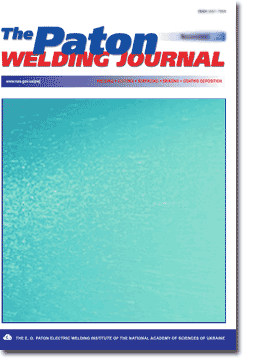

| SCIENTIFIC AND TECHNICAL | |
| Paton B.E., Yushchenko K.A., Kovalenko D.V., Krivtsun I.V., Demchenko V.F. and Kovalenko I.V. Role of keyhole in formation of deep penetration in A-TIG welding of stainless steel | 2 |
| Given are the results of experimental studies of size and shape of the weld pool in TIG and A-TIG welding of stainless steel of the 12Kh18N10T type (304H) using the surface arc with incomplete penetration. It is suggested that one of the causes of deep penetration in A-TIG welding is formation of a keyhole and associated change in intensity of Marangoni convection. Configurations of the free surface and bottom of the weld pool, which are characteristic of A-TIG welding, confirm this mechanism of deep penetration. | |
| Markashova L.I., Grigorenko G.M., Lozovskaya A.V., Kushnaryova O.S. and Fedorchuk V.E. Effect of scandium additions on structure-phase state of weld metal in aluminium alloy joints after heat treatment | 7 |
| Effect of heat treatment (ageing at 350 °C, 1 h) on changes in structure-phase composition of weld metal in 1460 alloy joints produced by argon-arc welding using Sv1201 and Sv1201 + 0.5 % Sc fillers is considered. It is shown that heat treatment leads to a considerable increase in volume fraction of fine phases, differing in morphology and phase composition. In metal containing no scandium, Al-Cu phases differing in copper concentration are formed, while Al-Li phases have a more complex structure due to inclusions of fine Al-Zr and Al-Cu phases. Complex phase precipitates of the lamellar (Al-Cu/Al3Sc) and globular (Al-Li/Al-Zr, Al=Sc) types are formed in Sc-containing metal. | |
| Gladky P.V., Pavlenko A.V. and Pereplyotchikov E.F. Temperature and geometrical dimensions of weld pool in plasma-powder surfacing | 12 |
| The paper presents the results of an experimental study of temperature, mass and dimensions of the weld pool and deposited layer in plasma-powder and argon-arc consumable electrode surfacing. | |
| Girenko V.S., Rabkina M.D. and Girenko S.V. Evaluation of crack resistance of welded joint metal based on the results of standard mechanical tests with regard for the dimensions of stuctural elements | 16 |
| An evaluation of static crack resistance (K1c, d1c) of structural steels and their welded joints is proposed, based on standard mechanical testing and impact toughness of Charpy samples, allowing for the dimensions of structural elements. The developed approach allows for the difference in the deformation gradients in the tip of a crack-like defect and notch of a Charpy sample, which results in that the structural parameters, responsible for fracture initiation, are under different loading conditions depending on their dimensions. | |
| Skachkov I.O., Pirumov A.E., Maksimov S.Yu. and Prilipko E.A. On neural network application for welded joint quality control in underwater welding | 21 |
| Artificial neural networks have been used to asses the quality of underwater welded joints with four types of fit-up defects: edge misalignment, change in part-to-torch distance, change in the gap between the parts and presence of tack welds. The efficiency of neural network application for the above types of defects is shown, except for a change in the edge gap. | |
| INDUSTRIAL | |
| Cheng C.H., Chan L.Т., Chow C.L. and Lee Т.C. Laser welding and formability study of tailor-welded blanks of different thickness combinations and welding orientations | 25 |
| Tailor-welded blanks (TWBs) are tailor-made for different complex component designs by welding multiple metal sheets with different thicknesses, shapes or strengths prior forming. However, the forming performance of an intrinsic TWB is critically related to its own structures and designs, such as the thickness combination, as well as the location and orientation of weldment. In this study, a 2 kW Nd:YAG laser were used to butt-weld approximately 180 samples of stainless steel (AISI 304) TWBs with different dimensions (from 12.7 to 165.1 mm in width), thickness combinations (1/1, 1/1.2, 1/1.5, 1.2/1.2, 1.2/1.5 and 1.5/1.5 mm) and welding orientations (0°, 45° and 90°). Subsequently, Swift forming tests were carried out to study the forming performance of those TWBs. It was found that the formability of TWBs critically related to the quality of weld was very much affected by the welding parameters of the Nd:YAG laser. Also, the effects of different thickness combinations on the formability of TWBs were investigated through the constructed forming limit diagrams (FLDs). The results showed that the thinner part of TWBs dominated the majority of deformation similar to the FLD of the parent metal. The effects of different welding orientations on the forming performance of TWBs were examined from the failure analysis. | |
| Thomy C. and Seefeld T. Basics and applications of laser-GMA hybrid welding | 28 |
| A basic requirement for exploiting the specific advantages of laser-GMA hybrid welding is a comprehensive, fundamental understanding of the interactions of the two sub-processes laser welding and GMA welding, as their synergetic interactions significantly contribute to the advantages of hybrid welding. However, for an effective as well as efficient industrial application, a thorough analysis of the requirements of the specific applications and the industrial environment is a prerequisite. Thus, within this paper, after an overview on hybrid welding, some interaction phenomena between the sub-processes are given a closer look. Based on these considerations, two applications (laser-GMA hybrid welding in pipe production and in welding of extruded aluminium profiles in the railway industries) are discussed. | |
| Labur T.M., Grinyuk A.A. and Poklyatsky A.G. Mechanical properties of plasma welded joints on aluminium-lithium aloys | 32 |
| Comparative analysis has been performed of mechanical joints in high-strength aluminium alloys 1420 and 1460 made by plasma and nonconsumable electrode argon-arc welding, using batch-produced welding wires SvAMg63 and Sv1201 at alternating-polarity asymmetrical current. It is shown that the strength and fracture toughness of the welds in off-centre tension of specimens strongly depend upon the thermo-physical parameters of welding. | |
| Kuzmenko G.V., Kuzmenko V.G., Galinich V.I., OtrokovV.V. and Laktionov M.A. Single-pass arc welding of thick metal using embedded electrode | 35 |
| Welding methods commercially applied to join heavy metal sections have been analyzed. The advantages of introducing the electrode metal into a gap prior to welding are noted, and the possibility of providing a stable arcing in gaps less than 2 mm in size is shown. It is suggested that the extra filler metal should be introduced through channels in plate electrodes to compensate for the filler metal deficit developing during weld formation. A new method is offered for automatic single-pass arc welding of heavy metal sections, called embedded-electrode electric arc welding. Technical-economic characteristics of the new welding process are compared with those of the available processes, and examples of its application for welding different grades of steels are given. | |
| BRIEF INFORMATION | |
| Chigarev V.V., Kondrashov K.A. and Granovsky N.A. Improvement of quality of deposited metal in plasma-MIG cladding of aluminium alloys | 40 |
| Peculiarities of plasma-MIG cladding of aluminium alloys are considered. The cause of formation of oxide-type non-metallic inclusions in the deposited metal was found to be an oxide film on the surface of metal electrode. Suggested is the diagram of the plasma-MIG cladding machine operating in the pulsed mode, allowing removal of oxide film from the metal electrode surface. The results obtained show that it is possible to dramatically decrease the quantity of non-metallic inclusions in the deposited metal. | |
| Pashchenko V.N. and Solodky S.P. Magnetic control of low-temperature plasma flows in the processes of thermal spraying of coatings | 43 |
| The possibility of controlling the position of a low-temperature plasma jet by superposition of a transverse magnetic field on the initial section of the plasma flow was studied. It is established that the main parameters influencing the angle of the jet deviation, are the controlling electric magnet current and specific energy of the plasma jet. It is shown that the direction of plasma flow deviation depends on the directions of the magnetic flow in the zone of interaction and direction of the gas flow swirling. | |
| Patents in the field of welding production | 46 |
| Developed at PWI | 11 31 39 42 45 48 |
(You are viewing the simplified file contents)
The cost of subscription/purchase order journals or individual articles
| Journal/Currency | Annual Set | 1 issue printed |
1 issue |
one article |
| TPWJ/USD | 384 $ | 32 $ | 26 $ | 13 $ |
| TPWJ/EUR | 348 € | 29 € | 24 € | 12 € |
| TPWJ/UAH | 7200 UAH | 600 UAH | 600 UAH | 280 UAH |
| AS/UAH | 1800 UAH | 300 UAH | 300 UAH | 150 UAH |
| AS/USD | 192 $ | 32 $ | 26 $ | 13 $ |
| AS/EUR | 180 € | 30 € | 25 € | 12 € |
| SEM/UAH | 1200 UAH | 300 UAH | 300 UAH | 150 UAH |
| SEM/USD | 128 $ | 32 $ | 26 $ | 13 $ |
| SEM/EUR | 120 € | 30 € | 25 € | 12 € |
| TDNK/UAH | 1200 UAH | 300 UAH | 300 UAH | 150 UAH |
| TDNK/USD | 128 $ | 32 $ | 26 $ | 13 $ |
| TDNK/EUR | 120 € | 30 € | 25 € | 15 € |
AS = «Automatic Welding» - 6 issues per year;
TPWJ = «PATON WELDING JOURNAL» - 12 issues per year;
SEM = «Electrometallurgy Today» - 4 issues per year;
TDNK = «Technical Diagnostics and Non-Destructive Testing» - 4 issues per year.


